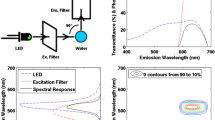Abstract
A common technique for ground water tracing uses continuous or discrete analysis of fluorescent tracer dyes to produce tracer breakthrough curves which can be analysed to determine ground water trajectory, velocity and dispersivity. Some fluorescent dyes are excellent tracers, but there remain significant constraints in fluorometry with respect to installation, control and data acquisition using standard filter fluorometers as well as with general analytical protocols. This paper identifies some of the constraints associated with the widely used Turner Designs Model 10 Series filter fluorometer and technical and operational solutions which can significantly improve the precision, accuracy and time resolution of tracer data.
Similar content being viewed by others
References
Alexander, E. M. Davis and Dalgleish, J.: 1986, ‘Dye tracing through thick unsaturated zones’, Proceedings of the 5th International Symposium on Underground Water Tracing, Athens, Inst. of Geol. and Mineral Expl., Athens, Greece, pp. 181–188.
Alexander, E. C., Jr., Alexander, S. C., Huberty, B. J. and Quinlan, J. F.: 1992, ‘The Oronoco Landfill dye trace III: Results from a superfund Remedial Investigation in a glaciated, diffuse-flow karst’, in: J. Quinland and A. Stanley, (eds.), Proceedings of 3rd Conference on Hydrogeology, Ecology, Monitoring of Ground Water in Karst Terranes, Nashville, Tenn., Dec. 4-6, 1991, NGWA, Dublin, Ohio, pp. 417–429.
Hill, M. C.: 1995, ‘Progress made in groundwater flow and transport modelling’, EOS Transactions of the American Geophysical Union 76, 393–394.
Hock, R., and LeB Hooke, R.: 1993, ‘Evolution of the internal drainage system in the lower part of the ablation area of Storglaciären, Sweden’, Geol. Soc. Amer. Bull. 105, 537–546.
Käss, W.: 1992, Geohydrologische Markierungstechnik, Gebrüder Borntraeger, Berlin 519 pp.
Quinlan, J. F.: 1991, ‘Use of dyes for tracing ground water: aspects of regulation’, in: Quinlan, J. F. and AS. Stanley (eds.) Proceedings of the Third Conference on the Hydrogeology, Ecology, Monitoring and Management of Ground Water in Karst Terranes, National Ground Water Association, Dublin, Ohio, pp. 687–696.
Smart, C. C.: 1988, ‘Artificial tracer techniques for the determination of the structure of conduit aquifers’, Groundwater 26, 445–453.
Smart, C. C. and Smart, P. L.: 1991, ‘Correction of background interference and cross-fluorescence in filter fluorometric analysis of water-tracer dyes’, Proceedings of the Third Conference on Hydrogeology, Ecology, Monitoring and Management of Ground Water in Karst Terranes, Association of Ground Water Scientists and Engineers. Nashville Tennessee, pp. 475–491.
Smart, P. L. and Laidlaw, I. M. S.: 1977, ‘An evaluation of some fluorescent dyes for water tracing’, Water Resources Research 13, 15–33.
Turner Designs: 1983, Operating and Service Manual, Model 10 Series Fluorometers, Mountain View, California, 36 pp.
Author information
Authors and Affiliations
Rights and permissions
About this article
Cite this article
Smart, C.C., Zabo, L., Alexander, E.C. et al. Some Advances in Fluorometric Techniques for Water Tracing. Environ Monit Assess 53, 305–320 (1998). https://doi.org/10.1023/A:1005816719920
Issue Date:
DOI: https://doi.org/10.1023/A:1005816719920




